How Long Does Sauerkraut Last in the Fridge
Properly stored sauerkraut can last considerably longer than most refrigerated foods due to its fermentation process and high acid content. Your homemade sauerkraut will stay fresh for 4-8 months in the fridge when kept at 38-40°F, while opened store-bought varieties typically last 4-6 months. Unopened commercial sauerkraut can maintain quality for up to 18-24 months in your pantry. You'll want to keep it in airtight containers like mason jars or glass crocks, ensuring the sauerkraut stays submerged in its brine. Watch for signs of spoilage such as unusual odors, mold, or slimy texture. Understanding proper storage techniques can help you maximize your sauerkraut's shelf life and maintain its probiotic benefits.
This post may contain affiliate links. If you make a purchase through these links, I may earn a commission at no additional cost to you. Additionally, portions of this post may be generated using artificial intelligence (AI) technology. While we strive for accuracy, please be aware that AI-generated content may not always be perfect and should be fact-checked when necessary.
The Spatula Scoops
- Homemade sauerkraut lasts 4-8 months in the refrigerator when stored properly at 32-40°F (0-4°C).
- Store-bought sauerkraut stays fresh for 4-6 months in the fridge after opening, while unopened lasts 18-24 months in pantry.
- Keep sauerkraut submerged in brine and stored in airtight containers like mason jars to maximize shelf life.
- Check for spoilage signs including unusual odors, visible mold, slimy texture, or dramatic color changes.
- Store sauerkraut on middle refrigerator shelves at 38-40°F (3.3-4.4°C), avoiding door storage where temperatures fluctuate.
Understanding Sauerkraut Shelf Life
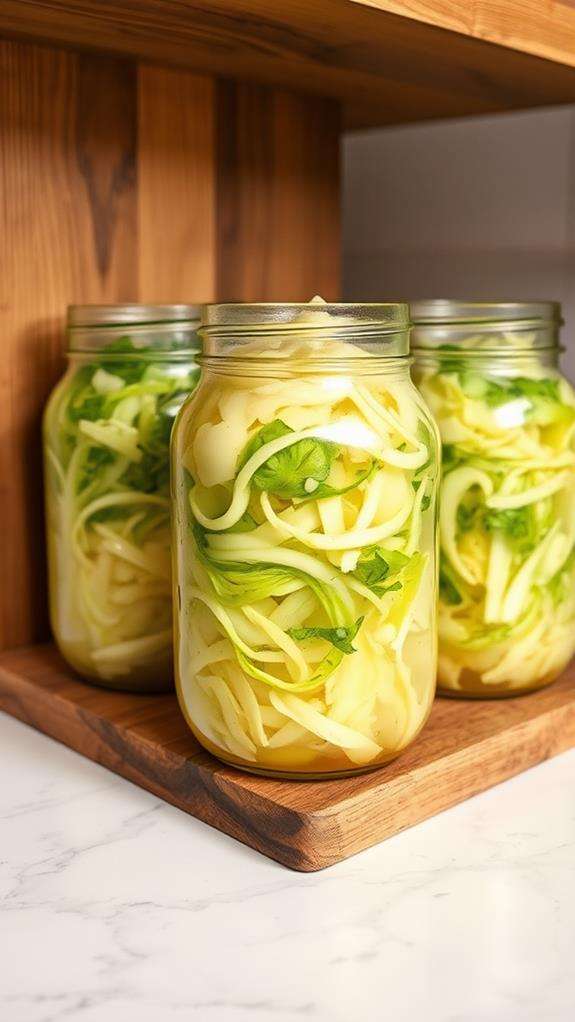
Generally, sauerkraut can last considerably longer than most fermented foods due to its high acid content and fermentation process. When you store it properly in your refrigerator, homemade sauerkraut typically maintains its quality for 4-6 months, while commercially produced varieties can last up to 12 months past their "best by" date.
You'll find that several factors influence your sauerkraut's shelf life, including storage conditions, container type, and initial fermentation quality. If you're keeping sauerkraut in an airtight container with its brine, you're creating an anaerobic environment that helps preserve the beneficial bacteria and prevents spoilage. The fermentation process produces lactic acid, which acts as a natural preservative.
To maximize shelf life, you should always use clean utensils when serving, keep the cabbage submerged in brine, and maintain a consistent refrigeration temperature between 34-38°F (1-3°C). You can tell your sauerkraut is still good if it maintains its crispy texture, tangy smell, and characteristic pale color. If you notice any unusual odors, mold growth, or excessive softening, it's time to discard the batch.
Store-Bought vs. Homemade Storage Times
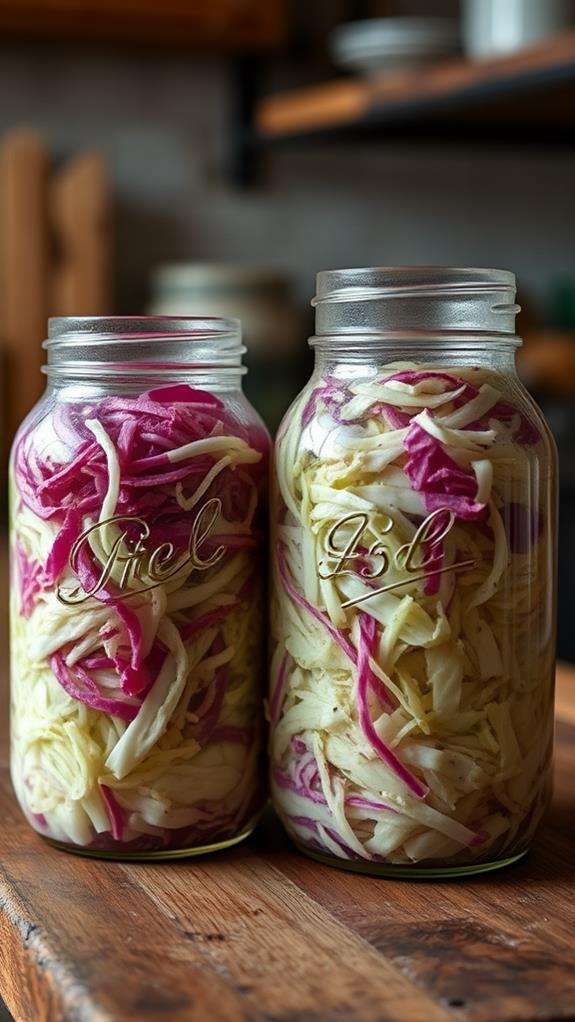
When you're comparing store-bought and homemade sauerkraut storage times, you'll find that commercial products typically last 4-6 months after opening in your refrigerator due to standardized processing and preservatives. Your homemade sauerkraut's shelf life can vary considerably, usually lasting 2-3 months when properly fermented and stored at a consistent temperature between 36-38°F (2-3°C). The storage duration of both varieties depends heavily on factors like container sealing, brine coverage, and your fridge's temperature stability, with warmer temperatures accelerating the fermentation process and potentially leading to over-soured kraut.
Commercial Product Storage Duration
Store-bought sauerkraut lasts considerably longer than homemade varieties due to commercial processing methods and added preservatives. When you're storing an unopened jar or can of commercial sauerkraut, you can expect it to maintain its quality for up to 18-24 months past the printed date if kept in a cool, dark pantry. Once you've opened the container, you'll need to keep it refrigerated.
In your refrigerator, an opened container of store-bought sauerkraut typically stays fresh for 4-6 months when properly stored at 40°F (4°C) or below. You'll want to make certain the sauerkraut remains submerged in its brine and that you're using clean utensils each time you serve it. The commercial product's shelf life is extended through pasteurization and standardized pH levels, usually maintaining a level between 3.4 and 3.7. When checking if your store-bought sauerkraut is still good, look for signs of spoilage such as an off-putting smell, unusual color changes, or visible mold growth. If the product develops any of these characteristics, you should discard it immediately, regardless of the date on the package.
Homemade Shelf Life Factors
Unlike commercial varieties, homemade sauerkraut typically lasts 4-8 months in the refrigerator when properly fermented and stored. Several key factors influence your homemade sauerkraut's shelf life, including the fermentation process, storage conditions, and your preparation methods.
You'll need to guarantee your fermentation reaches the right acidity level (pH 4.6 or lower) to prevent harmful bacteria growth. The temperature in your fridge should stay consistently between 32-40°F (0-4°C), as fluctuations can impact preservation. Your container choice matters greatly – you'll want to use clean, airtight glass jars with proper seals to maintain freshness and prevent contamination.
The quality of your cabbage and salt ratio also affects longevity. You should use fresh, crisp cabbage and maintain a salt concentration of 2-3% by weight. If you notice any signs of mold, unusual colors, off-putting smells, or texture changes, it's time to discard the batch. Keep your sauerkraut submerged under its brine, and don't contaminate it by using dirty utensils when serving. Following these guidelines will help maximize your homemade sauerkraut's shelf life.
Temperature Impact On Longevity
Temperature plays an essential role in determining how long both store-bought and homemade sauerkraut will last. Your refrigerator's consistent temperature of 32-40°F (0-4°C) creates an ideal environment for preserving sauerkraut's beneficial probiotics and extending its shelf life. When you store sauerkraut at room temperature, fermentation continues rapidly, which can lead to over-fermentation and spoilage within days.
- You'll notice your sauerkraut's crisp texture diminishing if exposed to temperatures above 40°F
- The tangy flavor you love will become increasingly sour at higher temperatures
- Your carefully crafted fermentation process can be disrupted by temperature fluctuations
- The probiotic benefits you're seeking might decrease with improper temperature control
- You risk losing months of potential storage time with inconsistent refrigeration
Store-bought pasteurized sauerkraut can tolerate slight temperature variations better than homemade versions due to its processing methods. However, you'll still want to maintain proper refrigeration for peak quality. If you're storing homemade sauerkraut, temperature control becomes even more critical, as the live cultures remain active and continue fermenting. Remember to keep your refrigerator's temperature steady and avoid leaving your sauerkraut out on the counter for extended periods.
Proper Refrigeration Temperature
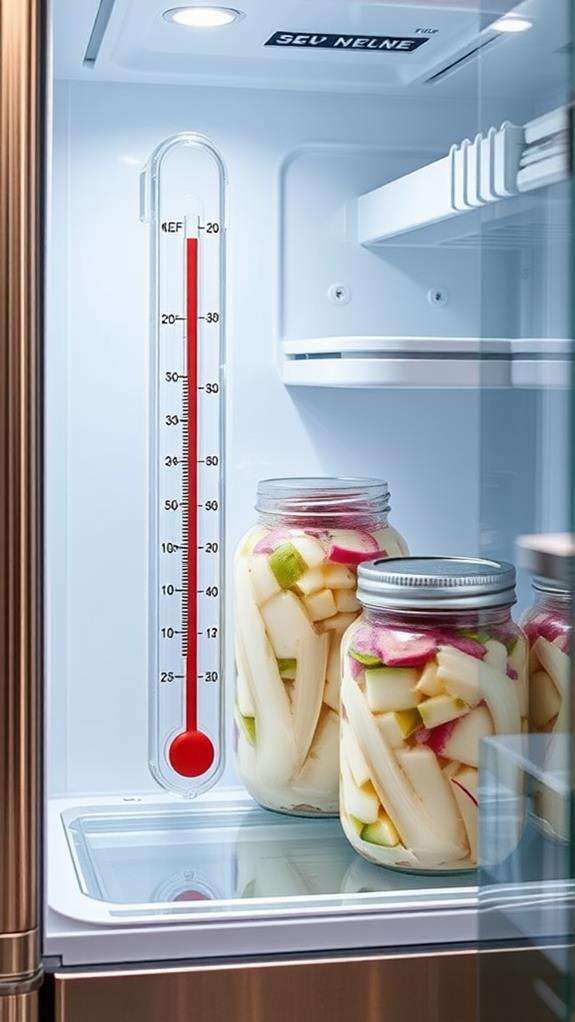
To keep your sauerkraut fresh and safe for consumption, you'll need to maintain your refrigerator at a consistent temperature between 38°F and 40°F (3.3°C to 4.4°C). The crisper drawer in your fridge typically provides an ideal storage zone for sauerkraut, as it helps regulate moisture levels while maintaining the proper temperature range. You should avoid storing your sauerkraut in areas of your refrigerator that experience temperature fluctuations, such as the door compartments or near the back wall where food items might freeze.
Ideal Temperature Range Settings
Maintaining your sauerkraut's quality and safety depends heavily on proper refrigeration temperatures. For ideal preservation, you'll want to keep your refrigerator's temperature between 38°F and 40°F (3.3°C to 4.4°C). This specific range helps inhibit bacterial growth while preserving the fermented cabbage's probiotic benefits and crispy texture.
To verify you're storing your sauerkraut at the right temperature, it's important to monitor your refrigerator's settings regularly. You can use a reliable refrigerator thermometer to verify the actual temperature, as built-in dials aren't always accurate.
- Your sauerkraut's beneficial bacteria thrive best in consistent cold temperatures
- Fluctuating temperatures can lead to continued fermentation and unwanted texture changes
- Too warm settings may cause your sauerkraut to become mushier than desired
- Extremely cold temperatures near freezing can damage the product's cellular structure
- Proper temperature control helps maintain that signature tangy flavor you love
If you notice your refrigerator struggling to maintain these temperatures, check the door seals and verify proper airflow around food items. Remember to position your sauerkraut container away from the door, where temperatures tend to fluctuate most frequently.
Safe Storage Zones
Beyond setting the right temperature, knowing where to place your sauerkraut in the refrigerator plays a key role in its preservation. You'll want to store your sauerkraut in the main body of your refrigerator, avoiding both the door compartments and the crisper drawers.
The middle shelf offers ideal temperature stability, as it's less affected by warm air that rushes in when you open the door. You shouldn't store your fermented cabbage in the door compartments, where temperatures can fluctuate by up to 5-7 degrees with each opening. The back of the middle shelf maintains the most consistent cold zone, typically staying between 37-40°F (2.8-4.4°C).
While your crisper drawers might seem like a logical choice, they're actually designed for produce with different humidity needs. Instead, place your sauerkraut container on a designated shelf space where it won't be crowded by other items. This placement guarantees proper air circulation around the container and prevents temperature pockets from forming. If you're using multiple jars, don't stack them directly on top of each other, as this can create warm spots between the containers.
Signs of Spoiled Sauerkraut
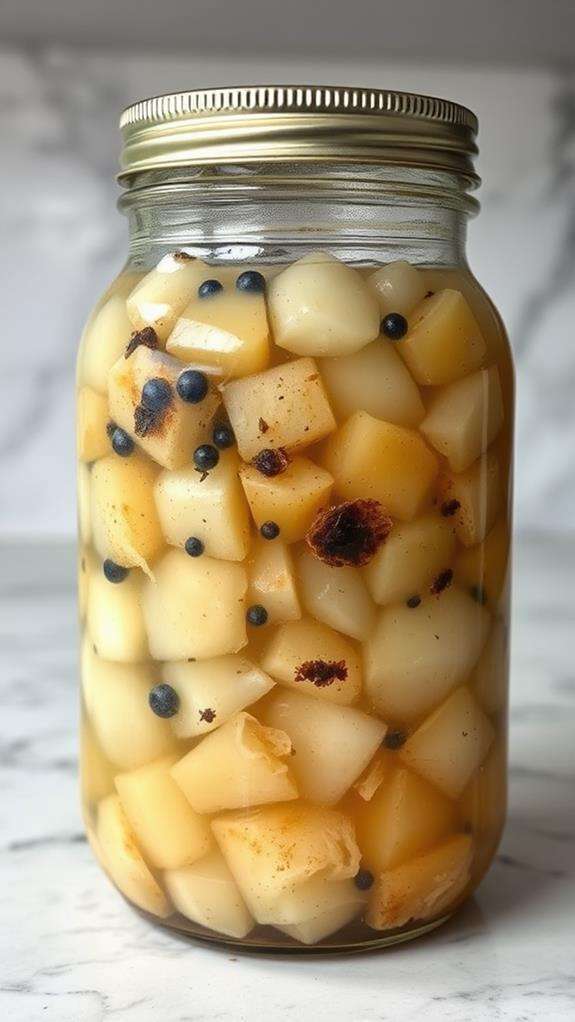
Here are the key indicators that your sauerkraut has gone bad:
- An overwhelming, offensive smell that's distinctly different from the normal fermented scent you're familiar with. Note that just as with uncooked rice, consuming spoiled foods can lead to food poisoning, so it's important to be vigilant.
- Visible mold growth, particularly black, blue, or pink spots on the surface or sides of the container.
- A slimy, unusually soft texture that feels abnormal when you touch the cabbage strands.
- Dramatic color changes, such as dark brown or grayish patches that weren't present before.
- Unusual bubbling or fizzing that occurs after the initial fermentation period has ended.
If you notice any of these warning signs, it's best to err on the side of caution and dispose of the sauerkraut immediately. While properly fermented sauerkraut can last several months in your refrigerator, consuming spoiled fermented foods can lead to food poisoning and other health issues.
Best Storage Container Options
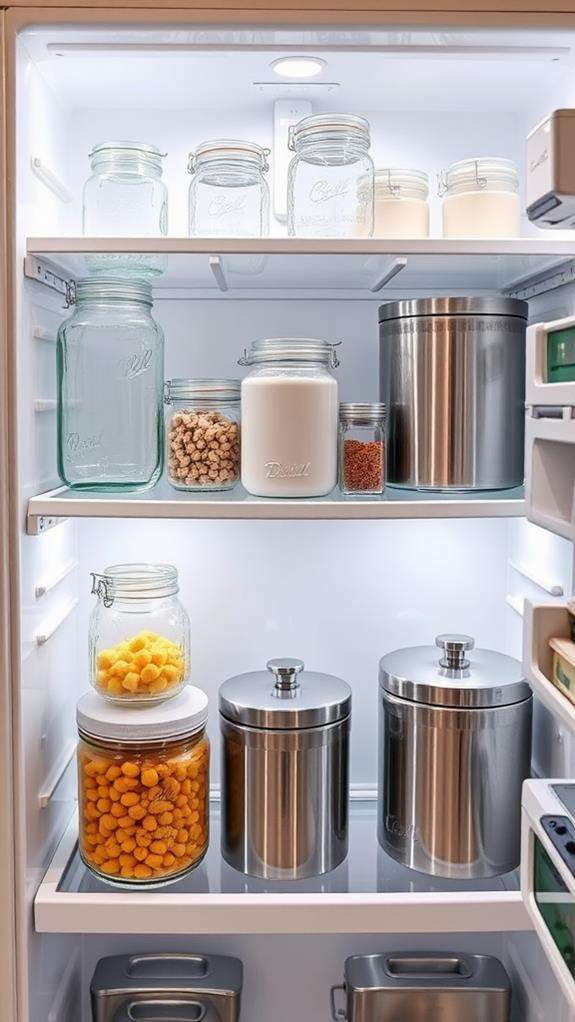
Proper storage containers play an essential role in extending your sauerkraut's shelf life. When choosing a container, you'll want to focus on options that maintain an airtight seal while preventing harmful bacteria from contaminating your fermented cabbage. Glass containers with tight-fitting lids are your best bet, as they're non-reactive and won't leach chemicals into your sauerkraut.
| Container Type | Recommended Use |
|---|---|
| Mason Jars | Best for home storage, airtight seal |
| Glass Crocks | Perfect for large batches, traditional |
| Ceramic Vessels | Good insulation, light-blocking |
| Plastic Containers | Short-term only, may absorb odors |
| Stainless Steel | Durable but can't monitor fermentation |
You'll want to avoid containers with metal lids that might corrode from the acidic content. If you're using mason jars, opt for plastic lids specifically designed for fermentation. They'll help release excess pressure while keeping oxygen out. When transferring store-bought sauerkraut, don't keep it in the original plastic packaging – instead, move it to an appropriate glass container with a tight seal to maintain freshness and prevent contamination.
Preserving Probiotic Benefits While Storing
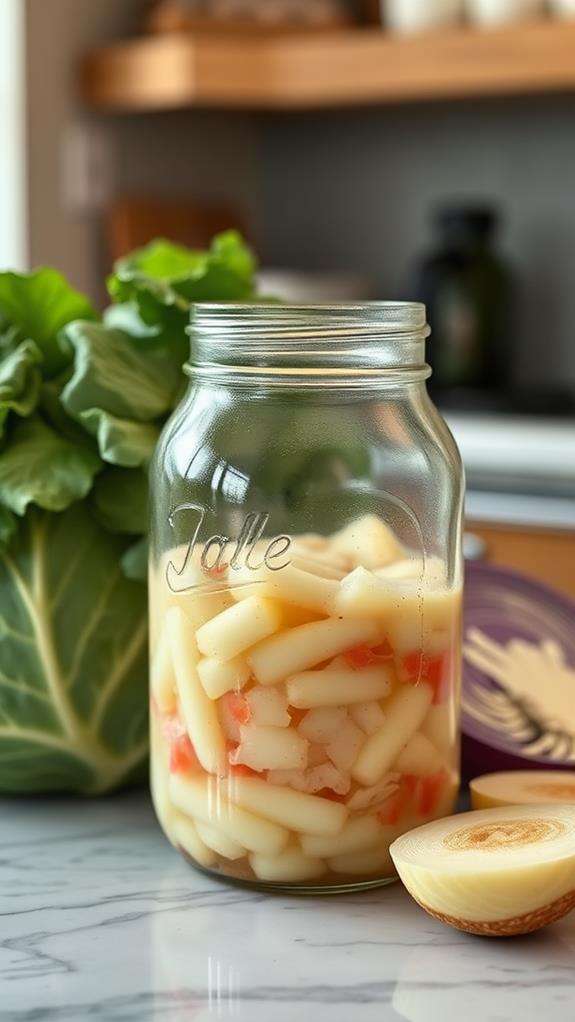
Maintaining the probiotic benefits of your sauerkraut requires careful attention to storage temperature and handling. When you're storing your fermented cabbage, keep the temperature between 36-38°F (2-3°C) to preserve those beneficial bacteria that make sauerkraut such a healthy choice. You'll want to make sure your refrigerator maintains consistent cooling, as temperature fluctuations can reduce the probiotic potency.
To enhance the preservation of probiotics in your sauerkraut, follow these essential guidelines:
- Always use clean utensils when serving to prevent introducing harmful bacteria
- Keep the sauerkraut submerged beneath its brine to maintain an anaerobic environment
- Minimize exposure to air by opening the container only when necessary
- Store away from direct light sources, even inside the refrigerator
- Press down any floating pieces to prevent mold growth
Remember that while your sauerkraut's flavor may continue developing during storage, the probiotic activity will gradually decrease over time. That's why it's important to consume your fermented cabbage within 4-6 months for maximum probiotic benefits. You'll know your sauerkraut is still good when it maintains its crisp texture and characteristic tangy aroma.
Freezing Sauerkraut
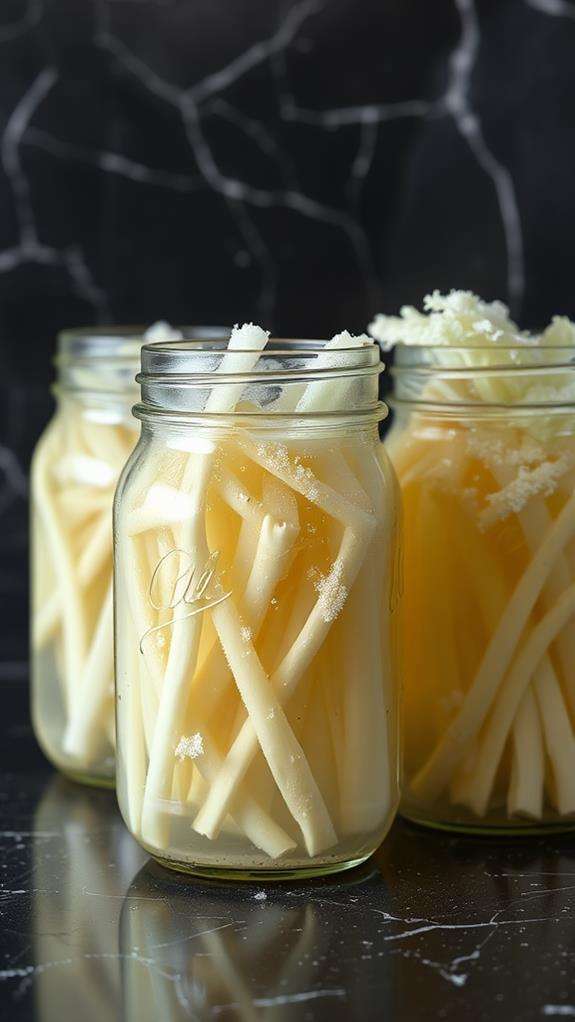
While freezing sauerkraut is possible, you'll sacrifice some of its prized qualities in the process. The freezing temperatures will greatly reduce the number of beneficial probiotics and alter the kraut's signature crispy texture, though the flavor generally remains intact.
If you decide to freeze your sauerkraut, you'll need to follow specific guidelines to maintain as much quality as possible. Here's how different freezing methods affect your sauerkraut:
| Method | Storage Time | Quality Retention |
|---|---|---|
| Vacuum Sealed | 8-12 months | Excellent |
| Airtight Container | 4-6 months | Good |
| Freezer Bag | 3-4 months | Fair |
| Original Container | 2-3 months | Poor |
| Loose Wrapping | 1-2 months | Very Poor |
When you're ready to freeze, drain excess liquid and pack the sauerkraut in appropriate containers, leaving about an inch of headspace for expansion. You'll want to thaw it slowly in your refrigerator when you're ready to use it, which typically takes 24-48 hours. Don't refreeze previously frozen sauerkraut, as this will further degrade its quality and potentially compromise food safety.
Safe Handling Guidelines
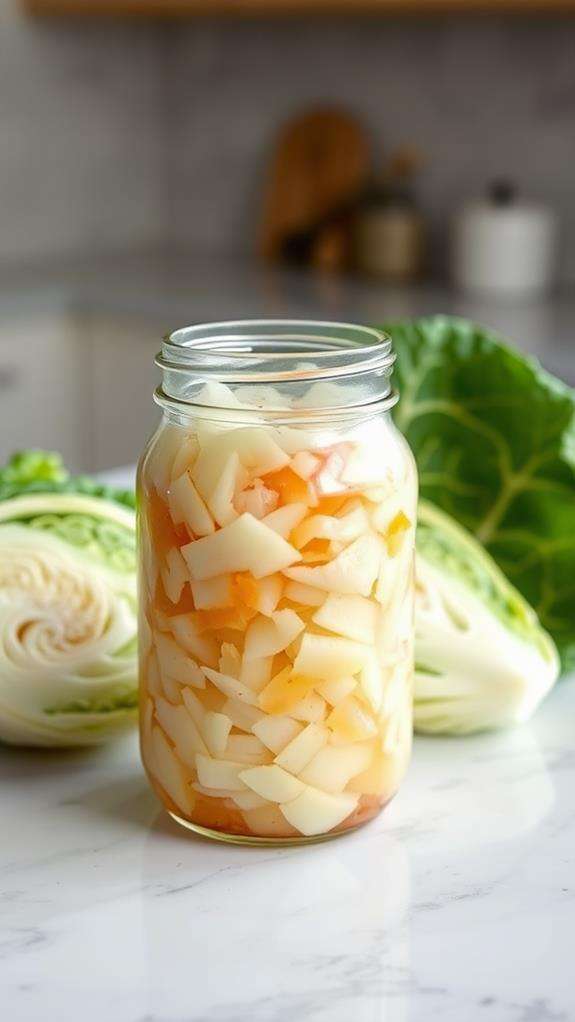
You'll need an airtight container with a tight-fitting lid, preferably glass or food-grade plastic, to store your sauerkraut safely in the refrigerator. For ideal preservation, set your refrigerator's temperature between 35-40°F (1.7-4.4°C), as higher temperatures can accelerate fermentation and potentially lead to spoilage. When transferring sauerkraut between containers, always use clean utensils and guarantee the kraut remains submerged in its brine to maintain freshness and prevent contamination.
Storage Container Basics
Proper storage containers play an essential role in maintaining your sauerkraut's freshness and safety. You'll want to choose containers that are airtight, food-grade, and specifically designed for fermented foods. Glass jars with tight-fitting lids work exceptionally well, while plastic containers might interact with the acidic nature of sauerkraut, potentially affecting both taste and preservation.
When selecting your storage container, consider these critical factors that'll impact your sauerkraut's longevity:
- A container that's too large will expose your sauerkraut to excess air, potentially leading to unwanted oxidation and spoilage
- Glass containers with rubber gaskets provide the ideal anaerobic environment your fermented cabbage needs
- Wide-mouth containers make it easier to remove sauerkraut without contaminating the remaining portion
- Dark-colored glass helps protect against light degradation, preserving beneficial probiotics
- Containers with airlock systems prevent unwanted bacteria while allowing fermentation gases to escape
Remember to always inspect your container for cracks, chips, or damage before use. If you're reusing containers, verify they're thoroughly cleaned and sanitized to prevent cross-contamination. The right container isn't just about storage; it's about maintaining the quality and extending the shelf life of your fermented creation.
Proper Temperature Settings
Temperature control serves as the cornerstone of safe sauerkraut storage, with ideal refrigeration between 32°F and 39°F (0-4°C). You'll need to monitor your fridge's temperature regularly to guarantee it maintains this ideal range, as fluctuations can affect both the fermentation process and preservation of your sauerkraut.
| Temperature Range | Impact on Sauerkraut |
|---|---|
| Above 40°F (4°C) | Accelerated fermentation, risk of spoilage |
| 32-39°F (0-4°C) | Ideal storage conditions |
| Below 32°F (0°C) | Texture damage from freezing |
| Door storage | Temperature fluctuations too high |
| Back of fridge | Most stable temperature zone |
Your refrigerator's temperature consistency plays a vital role in maintaining your sauerkraut's quality. You'll want to store your containers in the back of the fridge, where temperatures remain most stable. Don't place them in the door compartments, as these areas experience frequent temperature changes when you open and close the door. If you notice your sauerkraut developing an off-odor or unusual color, it's likely due to improper temperature control, and you should check your fridge's settings immediately.
Extending Your Sauerkraut's Freshness
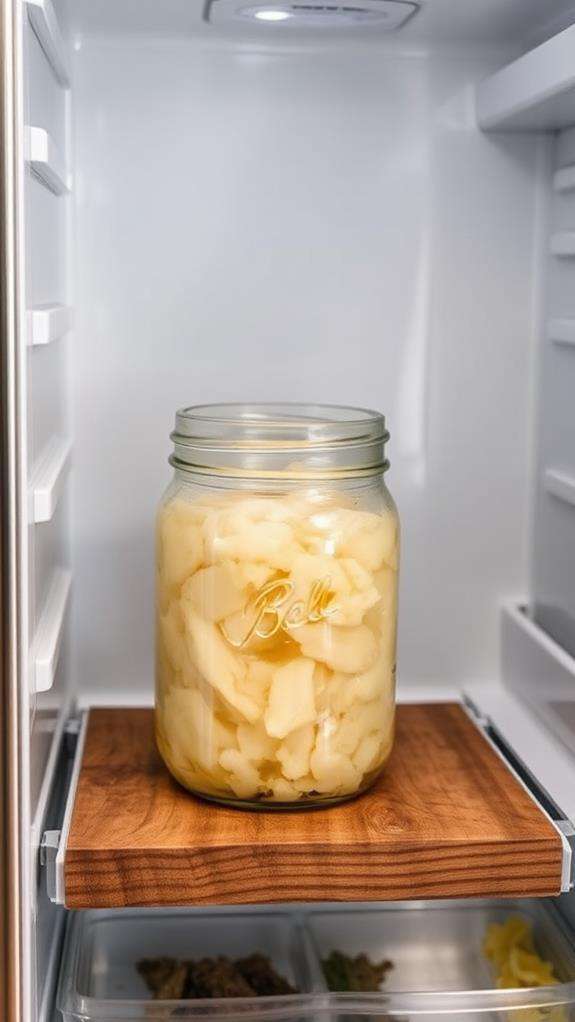
Maximizing your sauerkraut's shelf life comes down to a few key storage practices. You'll want to verify that every time you handle your fermented cabbage, you're using clean utensils and never introducing foreign objects into the container. When you're ready to serve some sauerkraut, make sure to press the remaining portion back down under the brine, as exposure to air can lead to unwanted bacterial growth and spoilage.
- You'll feel more confident about your sauerkraut's safety when you check for any unusual odors before each use
- You'll save money and reduce waste by transferring portions to smaller containers as you use them
- You'll maintain better texture by avoiding metal utensils, which can react with the acidic environment
- You'll protect your investment by keeping the lid sealed tightly between uses
- You'll preserve ideal flavor by minimizing the sauerkraut's exposure to air
Consider using glass weights or a cabbage leaf on top of your sauerkraut to keep it submerged in the brine. If you notice any browning or unusual discoloration, remove that portion immediately and verify the remaining sauerkraut is properly submerged. Regular monitoring and proper handling will greatly extend your sauerkraut's refrigerator life.
Common Storage Mistakes

While maintaining freshness requires careful attention, many people unknowingly make storage mistakes that can ruin their sauerkraut. You'll want to avoid using metal containers or utensils, as the acidic nature of sauerkraut can react with metal and affect both taste and safety. Instead, opt for glass or food-grade plastic containers.
Another critical mistake is not keeping the kraut submerged beneath its brine. When you expose the cabbage to air, you're creating an environment where harmful bacteria can grow. If you notice the brine level dropping, you can make a simple salt solution to top it off. Don't forget to check for signs of oxidation, which appears as brown spots on the surface.
You might also be tempted to frequently open your sauerkraut jar, but each time you do, you're introducing new bacteria and disturbing the anaerobic environment. It's best to use smaller containers so you can open one at a time. Additionally, leaving too much headspace in your storage container can lead to premature spoilage, so make sure your jar is filled to about 90% capacity with minimal air gaps.
Frequently Asked Questions
Can I Eat Sauerkraut Straight From the Jar Without Heating It First?
Yes, you can safely eat sauerkraut straight from the jar without heating it. In fact, raw sauerkraut often contains more beneficial probiotics than heated versions, as cooking can kill these healthy bacteria. You'll get the full tangy flavor and crisp texture when eating it cold. If you prefer it warm, that's fine too, but know that heating above 115°F (46°C) will reduce the probiotic benefits you'd get from the fermented cabbage.
Does Mixing Different Brands of Sauerkraut Affect Storage Time?
You can safely mix different brands of sauerkraut without affecting the overall storage time. The preservation factor depends on the brine's acidity and salt content, not the brand. However, you'll want to follow the shortest "best by" date among the mixed brands to be safe. Just make sure all brands you're mixing are properly fermented and refrigerated, and you'll maintain the typical 4-6 month storage window.
Should I Drain the Brine Before Serving Sauerkraut?
While you might think draining sauerkraut's brine makes serving easier, you'll want to keep that flavorful liquid. The brine isn't just salty water – it's packed with beneficial probiotics and adds authentic taste to your dish. You can serve your sauerkraut with a slotted spoon to control moisture, but don't discard the brine. If you're worried about excess liquid, just drain what's on your serving spoon, not the whole jar.
Can Pets Eat Sauerkraut Safely?
You can feed sauerkraut to your pets, but you'll need to be cautious. For dogs and cats, offer plain, unseasoned sauerkraut in small amounts (1-2 teaspoons for small pets, 1-2 tablespoons for larger ones). The fermented cabbage provides beneficial probiotics, but its high sodium content means it shouldn't be a daily treat. If your pet has digestive issues or shows signs of discomfort, stop feeding it immediately and consult your vet.
Why Does My Sauerkraut Taste Less Sour After Being Refrigerated?
If you've noticed your sauerkraut becoming less tangy in the fridge, you're experiencing a common fermentation slowdown. When you move sauerkraut from room temperature to cold storage, the beneficial bacteria that produce lactic acid become less active. Think of it like pressing pause on the fermentation process – the bacteria don't stop completely, but they work much slower in cold temperatures, which means less sourness develops over time.





